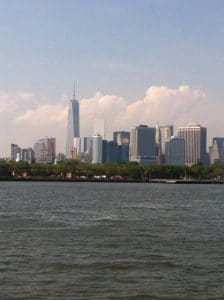“The rising air temperatures are having profound effects on sea ice, and on life on land and in the ocean, scientists said. The impacts can be felt far beyond the region, especially since the changing Arctic climate may be influencing extreme weather events around the world.”
“Persistent warming in the Arctic is pushing the region into “uncharted territory” and increasingly affecting the continental United States, scientists said Tuesday.
“We’re seeing this continued increase of warmth pervading across the entire Arctic system,” said Emily Osborne, an official with the National Oceanic and Atmospheric Administration, who presented the agency’s annual assessment of the state of the region, the “Arctic Report Card.”
“….The warmer Arctic air causes the jet stream to become “sluggish and unusually wavy,” the researchers said. That has possible connections to extreme weather events elsewhere on the globe, including last winter’s severe storms in the United States and a bitter cold spell in Europe known as the “Beast From the East.”
Some of the findings in the research, provided by 81 scientists in 12 countries, included:
-
The wintertime maximum extent of sea ice in the region, in March of this year, was the second lowest in 39 years of record keeping.
-
Ice that persists year after year, forming thick layers, is disappearing from the Arctic. This is important because the very old ice tends to resist melting; without it, melting accelerates. Old ice made up less than 1 percent of the Arctic ice pack this year, a decline of 95 percent over the last 33 years.
-
Donald K. Perovich, a sea-ice expert at Dartmouth College who contributed to the report, said the “big story” for ice this year was in the Bering Sea, off western Alaska, where the extent of sea ice reached a record low for virtually the entire winter. During two weeks in February, normally a time when sea ice grows, the Bering Sea lost an area of ice the size of Idaho, Dr. Perovich said.
-
The lack of ice and surge of warmth coincides with rapid expansion of algae species in the Arctic Ocean, associated with harmful blooms that can poison marine life and people who eat the contaminated seafood. The northward shift of the algae “means that the Arctic is now vulnerable to species introductions into local communities and ecosystems that have little to no prior exposure to this phenomenon,” the report said.
-
Reindeer and caribou populations have declined 56 percent in the past two decades, dropping to 2.1 million from 4.7 million. Scientists monitoring 22 herds found that two of them were at peak numbers without declines, but five populations had declined more than 90 percent “and show no sign of recovery.”
-
Tiny bits of ocean plastic, which can be ingested by marine life, are proliferating at the top of the planet. “Concentrations in the remote Arctic Ocean are higher than all other ocean basins in the world,” the report said. The microplastics are also showing up in Arctic sea ice. Scientists have found samples of cellulose acetate, used in making cigarette filters, and particles of plastics used in bottle caps and packaging material.”

